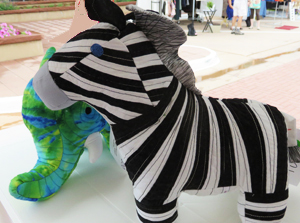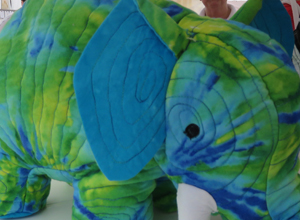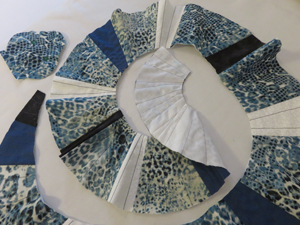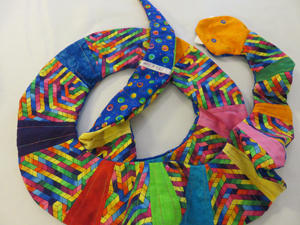Before retailers convince us that our children or grandchildren must have what many parents and grandparents will be buying for holiday gifts, let’s take a look at what artisans on the Front Range are offering. Every Wednesday for the next few weeks, “Handmade on the Front Range” will feature an artisan making items for children . . . and sometimes for our own inner child.
The bustle around Pat Abbitt’s booth of colorful stuffed animals at Boulder’s Firefly Market this summer looked a lot like Christmas season in July. The animals were making quite a stir when I came by . . . so let’s start there.
Lions and Zebras and Sheep . . . Oh My!

Stuffed toys by Pat Abbitt attracted buyers at July’s Firefly Market in Boulder. All of her animals show remarkable workmanship and attention to detail, including stitching on the feet appropriate for each type of animal.
Bright cotton prints adorned a variety of childhood favorites that Pat had made – lions, elephants, zebras, giraffes, hippos, and sheep, to name a few. “Yes, they’re machine washable,” I heard Pat telling interested visitors at her booth. Unique, colorful, and innately sweet, Pat’s creations were a natural to draw a crowd; but it was surely Pat’s workmanship that turned lookers into buyers.
I picked up a zebra and admired its secure seams and resilient shape. Most of all, I marveled at the decorative stitching that added detail to its stripes. Next to the zebra stood an elephant with decorative stitching that mimicked the folds of a live elephant’s skin. As I ran my hand over it, I realized that the stitching added texture as well as visual appeal by pulling the skin tight.
What a phenomenal amount of work, I thought to myself! I wanted to learn more about it, and Pat seemed delighted to oblige.
It’s a Zoo

Lines of decorative stitching gives Pat Abbitt’s animals texture and interest. Eyes are made of tight spirals of quilting thread stitched by machine.
Pat made her first elephant 13 years ago when her granddaughter was born, and she swore she would never make another. The work required was beyond reason, she decided, even for a grandmother.
Ever the seamstress, Pat turned her attention to making nursery ensembles ordered by decorators. Comforters, bumpers, dust ruffles, and curtains – whatever it took to complete a baby’s room, Pat made.
A few years went by and Pat started thinking how nice it would be for her customers to have a stuffed animal that matched the nursery. She pulled out the Rumpled Quilt Skins pattern that had given her so much grief and tried it again, this time making adjustments to construction techniques.

Pat Abbitt uses a wide variety of fabrics and patterns to make animals from It’s a Zoo unique. Pink and purple sheep on the middle shelf await the addition of fleece which Pat will add by hand, one ruffle at a time.
The elephants were such a hit that decorators were soon ordering just the elephants to put in children’s rooms for shows. Pat bought patterns for other animals to expand her offerings. Before long she was making far more animals than baby comforters.
One day she walked into her home workshop and was overwhelmed by all the pieces of projects lying around. She threw up her hands in the midst of all the fabric around her and exclaimed, “It’s a zoo!” With that, her business It’s A Zoo was officially born.
It’s A Zoo has become so successful, Pat wonders how she will keep up with demand. For starters, her granddaughter who received the first elephant 13 years ago now helps out by cutting some of the simpler pieces.
How the Animals Are Born

“It all begins with fabric,” Pat Abbitt said as she explained her production process in her home workshop in Broomfield. Certain prints speak of particular animals.
Pat still uses Rumpled Quilt Skins patterns for many of her animals, but she has also made some of her own, particularly when special requests have come from customers.
Her fabrics comes primarily from local quilt shops, where she finds 100% cotton prints with a high thread count and high-quality dyes. To buy wholesale, Pat explained, she has to buy complete bolts of fabric; so she buys smaller quantities at retail prices to keep variety at the Zoo.
No matter how high the quality, before quilting fabric enters the workshop, Pat launders it to make sure it won’t shrink or fade in a future wash.

Pat Abbitt lines every piece of her animals’ “skins” with muslin before adding decorative stitching.
Pearl the snake was in the early stages of production the day I visited Pat’s home workshop in Broomfield. Pat had lined Pearl’s “skin” with muslin, a thin woven cotton, and had started adding decorative stitching.
To add extra texture to skin of some animals, she places thin cotton batting (the filling used in quilts) between the outer print and the muslin.Whether she’s sewing straight lines on a snake’s back or curved lines on an elephant’s ear, Pat uses the same thread, equipment, and technique that a quilter would use.
Sylvia the snake was farther along than Pearl. With the print of the belly against the print of the back, Pat had stitched the seams not once but twice before turning Sylvia right side out – as she does with every animal.
Next she had given Sylvia a “hot bath” and time in the drier to shrink the muslin lining. When the muslin shrank, the decorative stitching pulled tight against the print skin, adding texture even where no batting was used.
The feeding stage comes next, according to Pat. Sylvia will eat premium polyester fiberfill until she’s stuffed. A tummy tuck will follow, Pat added – tiny hand stitches over the belly, pulled taut and closed tight.
Incidentally, Pat names all the animals she makes sometime during their production. She doesn’t know quite where the names come from . . . but to me they’re a sure sign she derives a lot of pleasure from each animal she makes.
Where to Find It’s a Zoo
Pat will set up her It’s A Zoo booth next at the Colorado Country Christmas Gift Show in Denver, November 7 – 9. Whether you plan to make the show or not, don’t miss the photos of Pat’s creations on the It’s A Zoo Facebook page. Be sure to scroll through all of Pat’s posts for an eyeful of adorable animals.
Hooked yet? The next place to visit is the ItsaZoo shop on Etsy, the online market of shops for handmade items. There you’ll find thumbnail photos of many more animals for sale. If you have a special request – a particular color you want in an animal, for example – you can send it to Pat by clicking “request custom order” in the left side bar. Or if you prefer, message Pat through Facebook or e-mail her at PAbbitt360@gmail.com.
A close-up of one of Pat’s sheep with ruffly fleece is the new cover photo on the Facebook page of “Handmade on the Front Range” as a herald of the new series on items for children. Please be sure to click “like” while you’re there and come back later to stay abreast of events and things you might want to know that don’t fit the weekly post.
Have you signed up for e-mail notifications of new posts? Your information won’t be used for any other purpose. You’ll find the sign-up box on the right side bar below “What’s Happening.”


This looks like it will be an interesting series and very timely with the holidays not too far off.
Good job!
Thanks for your comments, Susan. It’s definitely a fun series for me as blogger.